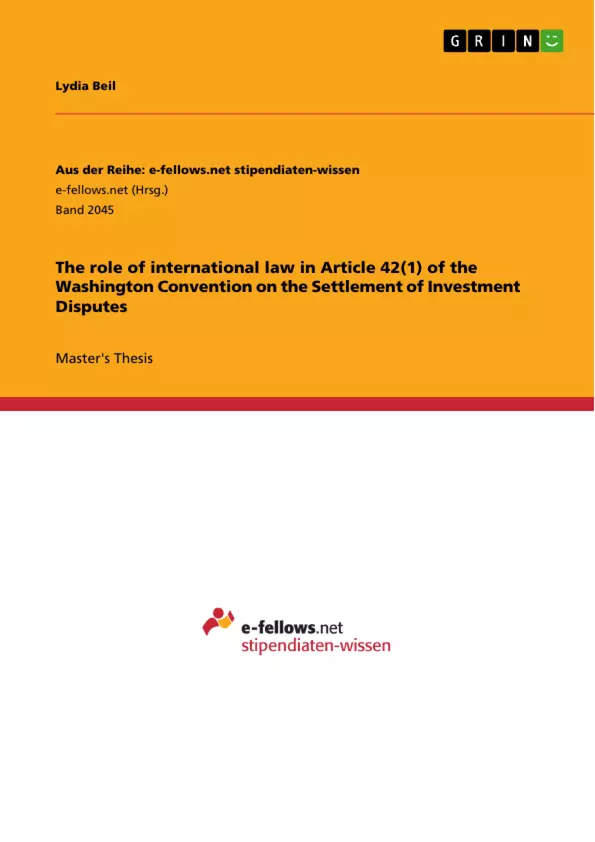The role of international law in Article 42(1) of the ICSID Convention is not very clear and has caused many debates. Scholarly opinions have therefore developed different theories. Some want to reduce the application to a minimum, the international ius cogens, whereas others argue that international law should prevail in all cases over the host state’s law. Some authors as well as the case-law also establish different limits. This paper analyses the role of international law with many different interpretative methods from civil law and common law. It concludes that no artificial limits can be maintained, but the current version of Article 42(1) leaves the determination of the scope of international law to the discretion of the tribunal. In order to clarify the notion entirely, more harmonisation of the substantive rules on foreign investment would be needed, either on the national or on the international level. Some future approaches are presented in this paper.
Inhaltsverzeichnis (Table of Contents)
- Table of Contents
- List of abbreviations
- Abstract
- I. Introduction
- A. What is the ICSID Convention?
- B. What regulates Article 42(1)?
- C. Overview of the problem
- II. Literature Survey
- A. Role of international law in Article 42(1), first sentence
- 1. International law as the chosen law by the parties.
- 2. International law in the absence of its choice
- a) Implicit negative choice to exclude the application of international law
- b) Application of international law to a certain extent
- 3. Conclusion and open questions concerning the role of international law under Article 42(1), first sentence
- B. Role of international law under Article 42(1), second sentence
- 1. Supplemental and corrective role
- a) Arguments
- b) Criticism
- 2. Limited supplemental and corrective role (ius cogens)
- 3. Applicability at all times
- a) Precedence of international law at all times
- b) Autonomous application of international law
- 4. Conclusion and open questions concerning the role of international law under Article 42(1), second sentence
- III. Research
- A. Research methodology
- B. Analysis
- 1. Textualist interpretation
- a) Literal interpretation: wording
- aa) Different languages
- bb) "and"
- b) Systematic interpretation
- aa) Position of international law within Article 42(1)
- bb) Other articles and provisions of the ICSID Convention
- c) Conclusion from the textualist interpretation
- 2. Historical interpretation of the wording: preparatory work
- a) Original aims
- b) Preliminary and first draft
- c) Discussion
- d) Final vote
- e) Conclusion from the historical interpretation
- 3. Casuistic interpretation: development of ICSID case-law
- a) Article 42(1), first sentence
- b) Article 42(1), second sentence
- aa) Earlier decisions
- bb) Supplemental and corrective role
- cc) Change to a broader formulation
- c) Conclusion from the casuistic interpretation
- 4. Comparative interpretation: analysis of external sources
- a) Former practice
- b) Arbitration rules
- c) Multilateral treaties
- d) Bilateral treaties: BITS
- e) Conclusion from the comparative analysis
- 5. Teleological interpretation: parties' interests
- a) Claimed interests
- b) Underlying interests
- c) Conclusion from the teleological interpretation
- IV. Conclusion and Future outlook
- A. Conclusions on Article 42(1), first sentence
- B. Conclusions on Article 42(1), second sentence
- C. Future Outlook
- Bibliography
- Table of ICSID cases
Zielsetzung und Themenschwerpunkte (Objectives and Key Themes)
This research project aims to analyze the role of international law in Article 42(1) of the ICSID Convention, which has been a subject of debate amongst scholars. The project examines various theories and interpretations, including those favoring a limited role for international law and those advocating for its broader application. It investigates the scope of international law's application and explores how the current wording of Article 42(1) allows tribunals to determine its scope.
- The role of international law in Article 42(1) of the ICSID Convention
- Different theories and interpretations regarding the application of international law
- The scope of international law's application in investment disputes
- Analysis of the current wording of Article 42(1) and its implications
- Future approaches to clarifying the role of international law in investment disputes
Zusammenfassung der Kapitel (Chapter Summaries)
- Introduction: This chapter provides an overview of the ICSID Convention and the specific problem addressed by the research project, which concerns the unclear role of international law in Article 42(1).
- Literature Survey: This chapter analyzes various scholarly opinions and case-law related to the role of international law in Article 42(1), both in the context of the first and second sentences. It explores different perspectives, including arguments for a limited role, a supplemental and corrective role, and the precedence of international law in all cases.
- Research: This chapter outlines the research methodology employed, followed by a detailed analysis of Article 42(1) using various interpretative methods. The methods include textualist, historical, casuistic, comparative, and teleological interpretations. Each interpretation is applied to both the first and second sentences of Article 42(1) and draws conclusions based on the findings.
Schlüsselwörter (Keywords)
The key focus areas of this research project include the International Centre for the Settlement of Investment Disputes (ICSID), the applicable law in investment disputes, and specifically, Article 42(1) of the ICSID Convention. This project aims to provide a deeper understanding of the role of international law in the context of investment dispute resolution within the framework of the ICSID Convention.
- Quote paper
- Lydia Beil (Author), 2011, The role of international law in Article 42(1) of the Washington Convention on the Settlement of Investment Disputes, Munich, GRIN Verlag, https://www.grin.com/document/335548



